The Latest from TechCrunch |  |
| Can the Statusphere Save Journalism? Posted: 11 Apr 2009 08:22 AM PDT
Recently, I enjoyed a refreshing and invigorating dinner with Walt Mossberg. While we casually discussed our most current endeavors and experiences, the discussion shifted to deep conversation about the future of journalism in the era of socialized media with one simple question, "are newspapers worth saving?" Walt thought for no more than two seconds and assertively replied, "It’s the wrong question to ask. The real question we should ask is if whether or not we can save good journalism." He continued, "Think about it. Of the hundreds, thousands, of newspapers around the country, there are really only a few that matter. Good journalism and journalists, on the other hand, are worth saving." Indeed. Perhaps good journalists, intuitive and ambitious journalists, might figure out how to survive this Darwinian state of media evolution on their own. Others may need the help of early risk-takers and success stories before being able to individually adapt to the socialization of content. My contemplative discussion with Walt explored the missteps of publishers and content producers and the corresponding opportunity for savvy individuals with relevant perspective combined with online social prowess. The persistent reverberation of those ideas in my head in the weeks to follow the exchange led me to explore the impact of the Statusphere on the authority of the blogosphere, as measured today. And it serves as my outline today. Whether it’s newspapers, television shows, or online mediums and networks, the shift is in consumption behavior, quality, relevance, and personality, not the production or distribution of content per se. As Walt said, "there are truly only a handful of media properties in print worth saving, the rest is comprised of great journalists and recycled national news." So what of those brilliantly articulate, passionate, and scintillating writers whom we identify, admire and connect with in each article they share? It’s not unlike the renaissance currently underway in the music industry. Artists are discovering that they have a Direct-to-Consumer (D2C) channel to reach fans and cultivate relationships. Those in touch with technology and the cultures of online societies can bypass traditional music production and distribution altogether. I guess I’m saying that at a time when traditional routes to journalism careers are being questioned, exceptional journalists can create their own destiny. Their future is in their notepads (or laptops), ready to escape from paper to online and the real world. The connection with readers, once established, multiplied, and fed, is seductive and unquenchable. Personality, motivation, determination, and the ability to embrace risk and venture into unchartered and unpredictable territory is the only way to champion change and influence the direction of professional adventures. Stop the Presses Believe it or not, in the overall theatrical production playing out as the world watches media Darwinism unfold, in the end it really doesn’t matter whether or not newspapers survive. We are witnessing and building the future of media production and associated connections right here, right now. Advertising in newspapers as well as print and broadcast media in general is spiraling irrecoverably without any hope of salvation. Subscriptions are evaporating and quickly eroding the supporting infrastructure for printing and delivering paper publications. The Rocky Mountain News and Seattle Post-Intelligencer have shuttered their print businesses and they’re not alone. These industry staples are merely the first to topple, triggering a domino effect that will resonate and replicate worldwide. Newspapers are swinging the axe and cutting staffs as though they were invading hordes while many are also reducing their publishing frequency. The rich and influential 200 year-old history that defines the legacy of independent media empires is now writing its next chapter for the history books. The still-powerful empires of print media will become a footnote in the future of all published media as the much younger, 15 year-old online medium competes for limited advertising revenue. This is just the beginning. According to Paper Cuts, a Web site tracking the newspaper industry, more than 120 newspapers in the U.S. have closed since January 2008 and at least 21,000 jobs at 67 newspapers have vanished. I’m sure that the number is much more dramatic now. To get a real time glimpse into the bloodshed, The MediaisDying on Twitter also maintains a running public account of all media properties as they announce layoffs, closures, and firings. Hope What eludes publishers is the very thing that can save them: the new model for not only surviving the evolution, but also thriving in the future ecosystem of publishing and connecting content with audiences—where they congregate online. The new media economy will embrace a shift in content creation and revenue generation from a top-down model to a bottom-up groundswell. The socialization of the web is powered by not only the ability for citizens to publish and share content, but also the wherewithal and associated rewards for connecting with the real people and the personalities with whom we follow. This is paramount as publishers and journalists can learn from the ongoing documentation in the art and science of online community building. Perhaps the reinvention of the publishing model starts with journalists who become the ambassadors for content and the flagship brand they represent. Why? There’s a direct correlation between the attention captured online and the loss of newspaper readers and subscribers as well as television viewers for that matter. Yes, many media properties are creating sophisticated web infrastructures and networks and are succeeding in attracting and maintaining visitors. Online advertising is the healthiest segment of advertising and it’s not entirely tied to the recession. The hunger for relevant, inspirational and compelling content is insatiable and potentially recession proof. To broaden revenue horizons, publishers are experimenting with the idea of micro payments, charging consumers a few cents to view stories and also resurrecting pay walls, which serve as a tollbooth between readers and deeper content. Because of the severity of the revenue blood loss, new ideas are introduced, reviewed, and tested almost daily. Adapting vs. Reinvention Content producers are scrambling to integrate social technologies and platforms to spur readership volume and interactivity among visitors and also between reporters and readers. And truthfully, this story is now years in the making. Maybe, just maybe, the existing model for generating, distributing and monetizing content could benefit from a Ctrl-Alt-Delete reboot. While newspapers and publishers explore new models for reversing the downturn, the real story resides with the very people whom they employ, the standout reporters and journalists who are worth saving. Waiting and hoping are not the catalysis for reinvention however. Taking control of individual destiny is a personal choice and commitment to change and shape the outcome of what lies ahead. It requires an immediate shift from operating behind the scenes to self-championing individual compositions. The most well-known, successful and celebrated journalists figured this out long ago. And those more assertive journalists who see the window of opportunity today aren’t necessarily waiting for approval or for existing processes to adapt to the new world order. Time waits for no one. Personality + Insight + Promotion + Interaction = Visibility and Community The socialization of the Web has given way to the era of personal brands. We are all now responsible for the creation, direction, perception, and management of our online personas, reinforced by what we share and how we interact across The Conversation Prism. This is incredibly poignant for journalists as they not only need to maintain a watchful eye on their media employer but also now compete against a new generation of bloggers and content producers who do not abide by or embody the classical rules and training of journalism. It’s survival of the fittest predicated by what you stand for and how hungry you are to build and sustain a community around you and your work. What’s taking place right now is an incredible opportunity for good journalists to humanize their stories and project an outward extension of their persona to connect with existing and potential readers at the point of attention aperture, the window of opportunity to engage someone on their own terms and in their own time. And, it’s no different than the tactics used by innovative, enterprising, and determined bloggers who aspire to create a congregation around their perspective. This was and is, all about people and a new breed of social journalism. To cultivate a personal brand or invest in online interaction is time consuming as the required investment is beyond one’s daily routine. It is however, rewarding and measurable. Michael Arrington and Erick Schonfeld interact with readers on Twitter, Facebook, and other social networks to stay connected, converse with peers, and also to meet people at events local and around the world. There’s a reason why 350,000 people follow TechCrunch on Twitter (being on the suggested list doesn’t hurt either). CNN’s Rick Sanchez boasts more than 75,000 followers on Twitter and uses the micro medium to source story ideas and interact with viewers. Also Anderson Cooper has cultivated a loyal following of 93,000 on Twitter by sharing interesting content through his timeline. Reggie Aqui uses Facebook to interact with viewers as well. Mary Louise Schumacher and Tannette Elie of the Milwaukee Wisconsin Journal Sentinel participate on Twitter in relevant conversations while also hosting and attending Tweetups to extend their personal brands online and in real life. Kirk Yuhnke, News Anchor for Fox 13 in Salt Lake City interacts with viewers and also those who share his views outside of his home base. He’s reaching a wider audience because of Twitter. John Byrne, Editor-in-Chief of BusinessWeek show’s us the human side of running the editorial side of a global media powerhouse NPR Scott Simon’s 167,000 followers on Twitter relish in his personal updates and responses. Ryan Squire of NBC 4 in Columbus leverages Twitter followers to collaborate on stories as well as simply engaging in real world conversations. Kara Swisher of AllThingsD and the Wall Street Journal shares updates, new thoughts, and also talks to people regardless of social stature. She’s built a global reputation through her work and insight, strengthened by her interaction across multiple social networks. Ron Sylvester, an award-winning journalist at the Wichita Eagle, tweets directly from the courtroom. He also blogs and connects with people on Facebook. The list grows every day. And, while many of these examples showcase Twitter and Facebook, the truth is that your community of potential viewers, readers, and stakeholders are engaging in multiple networks such as personal blogs, blog comments, Ning, Google and Yahoo Groups, Yelp, Upcoming.org, FriendFeed, and many others that surface with simple Web searches. Journalists and reporters benefit from reminding the world that they’re real people who are learning that genuinely connecting and participating online, outside of traditional walled gardens, allows the rest of the world to appreciate who they are and what they stand for. Participation also empowers an influential group of content ambassadors who broaden the reach of their own personal and media brands and associated stories by willfully sharing and introducing links to their personal network. These lessons are also critical for students who are learning about the past and the future in a real time collision of textbook cases combined with current online examples shared from peers and mentors in the field. The Statusphere is the Future of Social Syndication We’re shifting into a rapid-fire culture that moves at Twitter time. Attention is a precious commodity and requires a personalized engagement strategy in order to consistently vie for it. The laws of attraction and relationship management are driven by the ability to create compelling content and transparently expose it to the people whom you believe benefit the most from it. The Statusphere is the new ecosystem for sharing, discovering, and publishing updates and micro-sized content that reverberates throughout social networks and syndicated profiles, resulting in a formidable network effect of activity. It is the digital curation of relevant content that binds us contextually to the statusphere, where we can connect directly to existing contacts, reach new people, and also forge new acquaintances through the friends of friends effect (FoFs) in the process. Twitter, Facebook News Feeds, FriendFeed and other micro communities that define the Statusphere, are driving action and determining the direction and course of individual attention. It is inducing a more participatory, engaging, and enlightened community of media-literate information socialites. I’d also argue that the Statusphere will ultimately replace bookmarks and RSS feeds as a traffic driver for the masses, as we increasingly rely on friends and peers to serve as our social seismograph for relevant and contextual data. Journalists must tap the Statusphere in order to earn awareness for their work and more importantly, build relationships with those who share affinities for the topics they cover. While traditional media models lived and breathed through the sharing of content directly to the existing readership, new media will thrive from those individuals who reach people where they interact and hand-deliver relevant information directly to them. News Feeds and Timelines serve as our centralized attention dashboard and determine what we read, what we say, and who responds simply by the information that continually flows through it. We’re engaged at the point and place of introduction and bound by context and time. Noticeable content sparks curiosity and dictates our next move and subsequently the next moves and reactions of friends and friends of friends (FoFs). For journalists, it’s now their job to identify who these influencers are in order to establish an effective contextual network. With each new connection, journalists can appear in multiple, dispersed timelines to syndicate content across the social graph and social networks. Worthy content combined with evangelism and clever promotion will earn visibility and expanded syndication through retweet (RT), link shares, Diggs, Stumbles, bookmarks, tweetbacks, Likes, and other forms of social syndication. With each new instance of sharing, content reverberates through extended social graphs. Content becomes a social object that inspires communication and action. The Human Network and the Future of Socialized Journalism The Human Network is powered by context. We learn by listening to relevant signals to learn from others who share our interests and passions. The idea is to complement individual connections with the creation of community around your personal brand supported by your associated views and perspectives. We identify uniquely with different individuals across varying topics, but the timing of each update we share, which serves as the disruption point, combined with the state of the extended attention aperture of friends and FoFs are perhaps the most important factors in determining the thread and viral opportunity for potential conversations surrounding content. It is the Social Effect that determines actual reach, resonance and the course for individual content. If you are a journalist, it’s now your responsibility to create a dedicated tribe that supports, shares, and responds to your work and personal interaction in both the Statusphere and also at the point of origin. It’s the only way to build a valuable and portable community around you and what you represent. Savvy publishers and content producers will also benefit from the extended visibility and vibrancy of the supporting conversations and should in turn build and support campaigns and presences that promote the individual in addition to the media brand to create a dynamic and blooming human collective. Monetization is then influenced by the earned social capital and currency that is valued and measured through relationships and dialogue. The humanization and socialization of journalism will create a viable platform for meaningful engagement that builds a new era of trust, loyalty and community around the media brand, one person at a time. Concurrently, it establishes a vibrant and collaborative highway to source and share stories by the people for the people to shape stories that matter beyond the assignment desk. Consumers are then vested in media and boast a sense of ownership and pride to have earned the opportunity to help shape its direction. Content, and the reporters and journalists who produce it, must migrate to the individual attention dashboard in order to trigger a reaction that reverberates across the social graph and become gathering points for individual tribes. The key is held by perceptive and enterprising individuals who can attract, build, and foster flourishing audiences, and must be empowered to do so in order to lead viewers, friends, and friends of friends back to the original font of information—creating a new source of information stakeholders from the outside in. Thanks for reading this far. If you would like to continue this conversation, connect with me on Twitter, Jaiku, LinkedIn, Plaxo, FriendFeed, or Facebook. (Photo by swanksalot). Crunch Network: MobileCrunch Mobile Gadgets and Applications, Delivered Daily. |
| Live from the PragueCrunch II Meet-up Posted: 11 Apr 2009 04:34 AM PDT Welcome to PragueCrunch II, Prague’s foremost party held in Prague every year around the time TechCrunch writers feel like going to Prague to drink great beer and talk start-ups, tech, and gadgets. We’ll be streaming live through Qik and posting images throughout the day. If you’re still vacillating and you’re in Prague, come on down! We’ll be at Hergetova Cihelna from 2pm until late in the evening. Confounded as to whether to come at like 11pm? Check my Twitter Updates to see if we’re still at the event or if we’ve moved on. Otherwise, expect to see Robin and I there all night. Special thanks to the venue and all the great sponsors. Click through for live video feeds throughout the evening.
Special thanks to these fine folks: Gold Sponsor:Dial Telecom Dial Telecom provides services for both the wholesale and the retail sectors. Our wholesale sector specializes in providing cable ducts, dark fibre and backbone capacity to international and national carriers, ISPs, and ASPs. Dial Telecom also provides IP-based services to regional ISPs over its own fibre network. The company has an exceptionally well-developed Ethernet over fibre network and DWDM connections to most major regional capitals. Dial Telecom is connected to the world's largest Internet exchanges (most notably to DE-CIX and KleyerEx in Frankfurt am Main, AMS-IX in Amsterdam, LINX in London and ECIX in Düsseldorf). Naturally, it is also connected to Czech NIX.CZ and Slovak SIX.SK. The Dial Telecom company is part of the well-established international Dial Telecom Group (Dial Telecom CZ, Dial Telecom SK, eTel SK and Telecom Austria Czech Republic (Volný, a.s.). The group actively contributes to the consolidation of the fixed telecommunications market. The most significant acquisitions in the last year have been eTel Slovakia and Telekom Austria Czech Republic (Volný brand). Adamantium Sponsors: Ataxo has offices in the Czech Republic, Poland and Slovakia. We provide expert Search Engine Optimization and manage several thousand Pay-per-Click Campaigns for our clients from these countries as well as outsource Pay-per-Click Campaigns for clients from other parts of the world. Binary Age Geewa Kerio Learn10 Learn10 is the work of a European team of four, split between Birmingham, UK and South Bohemia, CZ. It is inspired by the efforts of three of the founders to learn Czech, and informed by experience in advertising research analysis & English teaching. With 27,000 members this self-funded project is one year old. After extensive testing based on the prototype - LearnItLists - they have re-branded to Learn10 and are ready to launch. TasteKid WebExpo 2009 Wirenode Zeality Crunch Network: CrunchGear drool over the sexiest new gadgets and hardware. |
| Report: Founders Want To Buy Skype Back From EBay Posted: 10 Apr 2009 06:33 PM PDT
As the New York Times reported, Skype’s founders, Niklas Zennstrom and Janus Friis, are in talks with several private equity firms and are amassing their own financial resources to make a bid for the internet phone business. eBay bought Skype from Zennstrom and Friis for around $3.1 billion in 2005. We reported last year that eBay would be willing to sell Skype if the company couldn’t support eBay’s core ecommerce business. eBay has been having trouble finding ways of using Skype across its other products. eBay removed Skype co-founder and CEO Niklas Zennstrom in October 2007, reportedly due to frustration at the financial performance of Skype. Ebay also negotiated down the huge earnout due to Skype stockholders and took a $936 million one-time loss around the transaction. As we wrote last spring, a sale was projected to be likely late last year or in the first half of this year. Of course, with the economy in such poor condition, the sale was probably put off momentarily. There was something brewing between Google and Skype last spring, but nothing came of it. Google recently launched its own voice product, Google Voice (formerly Grand Central). Skype recently launched a nifty iPhone app, which was downloaded 1 million times in the first two days of its release. Skype recently made a move to be a player in the enterprise space, but it wasn’t clear how much of a money-maker the new service would be. There’s no doubt that Skype brings a lot to the table but eBay was probably just not the right buyer. Skype’s scalable technology and a proven platform in the VOIP, VOIP2POTS and P2P Video is impressive to say the least. The service currently has more than 405 million registered users. Following their respective departures from Skype, Zennstrom and Friis formed VC firm Atomico and founded online video/TV site Joost. Crunch Network: CrunchBoard because it’s time for you to find a new Job2.0 |
| President Obama, Where’s Our CTO? Posted: 10 Apr 2009 03:17 PM PDT  President Obama incorporated technology into his election campaign in an unprecedented way, became known as the YouTube president within the first week of being elected, and seems to be forward thinking in his views on innovation and technology, which is why we endorsed him last year. But now we are almost four months into his tenure as President and leader of the free world, and the Obama administration has yet to name a Chief Technology Officer. They have, I should note, appointed a Chief Information Officer, Vivek Kundra, the former CTO of Washington D.C., whose office is being investigated by the FBI for bribery and money laundering (which apparently occurred when he was the boss). Still, it’s confusing as to why the President is taking his sweet time to appoint a CTO, when there are clear issues that a CTO could be working on. For starters, there are tech-centric issues like the FCC’s National Broadband Plan to give all American’s high speed internet access, and the DTV Delay Act, which was signed into law in early February. There’s the Open Government initiative, through Change.gov, which seems to be in a stalemate. And certainly a CTO could lend his or her expertise and leadership in incorporating technology into the President’s health-care, education and energy initiatives. Take a look at the technology issues page of the White House’s website for a more extensive to-do list awaiting our future CTO. And there’s definitely no dearth of talent for this position. The names that have been bandied about for the position even before President Obama was victorious in November include Bill Gates, Microsoft founder; Padmasree Warrior, Cisco’s CTO; Eric Schmidt, Google CEO and longtime Obama supporter (but he apparently said no to the job); Vint Cerf, the so-called “father of the internet” and VP at Google; Lawrence Lessig, Stanford Law professor and founder of the school's Center for Internet and Society; Ed Felton, Princeton computer science professor and founder of Princeton's Center for Information Technology Policy; Jeff Bezos, Amazon’s founder and CEO; and Steve Ballmer, Microsoft’s CEO. Perhaps the Obama administration is being extra careful not to make another “Kundra” mistake and is carefully evaluating the backgrounds of each candidate. But this should hardly take 5 months. Regardless of what the holdup is, we need someone with true technology smarts in the White House soon. I mean, how hard can it be to find a technology exec that has paid his or her taxes? Give us your favorite candidates for America’s CTO in comments. Or take our poll. Crunch Network: CrunchGear drool over the sexiest new gadgets and hardware. |
| Current TV Cancels $100 Million IPO Posted: 10 Apr 2009 03:16 PM PDT Current Media, the media company backed by former Vice President Al Gore, has cancelled the $100 million IPO that it originally announced in January 2008. In a document submitted earlier today, Current TV attributed the IPO’s cancellation to the current economy:
The media company is best known for cable channel Current TV, which is broadcast internationally to 59 million homes with markets in regions including the United States, Italy, and the UK. Current also has a strong web presence, tapping into popular social media services like Digg and Twitter for special events like the 2008 presidential election. The network’s social media efforts during the election were deemed a success by the company, but it was still hit by layoffs in November, when it said that the IPO was being “put on hold”. Current says that there have have been no further layoffs since then, and that the direction of the company has not changed. Via PEhub Crunch Network: CrunchBoard because it’s time for you to find a new Job2.0 |
| Elevator Pitch Friday: Smallaa Lets You Sort Your Activity Stream By Topic (Invites) Posted: 10 Apr 2009 02:22 PM PDT
It is becoming clear that activity streams are taking hold as the default communications interface across a wide variety of social networks and media, from Twitter to Facebook to FriendFeed to Bebo and beyond. Yet the more people we try to keep track of in one consolidated feed, the more noise we have to deal with that increasingly threatens to drown out those golden information nuggets we all seek. So it is appropriate that today’s Elevator Pitch comes from Smallaa, a startup that aims to help people sort and categorize their streams by interests. Smalla is still in private beta, but TechCrunch readers can sign up with the promotion code c3p0. When you sign up, you can bring in your FriendFeed stream. (Integration with Facebook is scheduled for April 23, and then Twitter will come after that). Your regular FreindFeed stream appears in a column on the right. You also pick what interests you want to follow. For instance, I picked “Internet Startups,” “Technology,” “Google,” and “Unusual Things.” I could have also picked “best Photos,” “Pets,” “Formula 3 Racing,” “home,” or I could have created my own topics. Those selections create an interest stream on the left. This is the main Smaalla stream. There are two ways you can inject something into the Smallaa stream. You can add it directly as a comment, link, video, or picture and assign it to an interest category when you place it into the stream. (Smallaa asks “What’s going on in your interests?” That could probably be clearer. A simple, “What are you intersted in?” would do.) The second way to inject items into the Smallaa stream is to assign them directly from the FriendFeed stream on the right (which will expand in the future to include Facebook and other streams as well). For instance, Robert Scoble just wrote a post and did a video trying to explain why Mike is wrong about FriendFeed because of its superior mechansims for picking out signal to noise compared to Twitter. Scoble is particularly enamored with FriendFeed because he can pick out what’s interesting based on how many comments an item gets or how many people liked it. Yet with Smalla, I can simply grab the link to Scoble’s post from my FriendFeed stream and assign it to my “Technology” interest in Smallla. I trust what Scoble has to say about technology, so I pay attention to that, but I can ignore his comments about how awesome it is to live in Half Moon Bay. Now, everybody in Smalla following with an interest in technology will see that link to Scoble’s post and any comments I have about it (unless they choose to view only items from people they follow in Smalla). The relationship between Smallaa and other services is reciprocal. When I add a post to Smallla, it appears in FriendFeed as well. And whenever you assign an item from a friend in another service, it prompts you to invite them to follow the particular interest you are assigning their item to in Smallla. Finally, as another way to figure out who to pay attention to, for each item in your Smallaa feed, it shows you how many people are following the person who posted it in that category. So again, to pick on Scoble, he might quickly gain the most followers in technology but not so many in fashion. Hopefully, this would create a reinforcing feedback loop which would encourage Scoble to write and share more about technology and less about his favorite pair of pants. Or as Smalla CEO and founder Tim Lai says in the Elevator Pitch video below, it would be great to follow what Bill Clinton has to say about “politicians or giving public speeches without ever being distracted if he has anything to say about honesty and family values.” Lai built and sold his first software company in Hong Kong, an enterprise document management company called Paradigm, before moving to California. He has invested $3 million of his own money to start Smalllaa. His pitch would probably have been less confusing if he explained why he is sitting in a racing car at the beginning, but he comes around to that in the end. If you would like your startup to be featured on TechCrunch, submit your Elevator Pitch. Crunch Network: CrunchBase the free database of technology companies, people, and investors |
| Tesla’s Elon Musk Calls NY Times Writer Stross “A Huge Douchebag…And An Idiot” Posted: 10 Apr 2009 01:48 PM PDT Undoubtedly Tesla isn’t going to be happy about this video getting attention, but I think it’s awesome to see CEO Elon Musk take a stand against the company’s many detractors. Last November New York Times writer Randall Stross trashed Tesla as a rich man’s car that the government should shun. "Only the Rich Can Afford It. Should Taxpayers Back It?" he wrote.
That rewriting, though, apparently hasn’t appeased Musk. In an interview last week (video above) with Yahoo TechTicker, Musk calls Stross a “huge douchebag…and an idiot” (skip to the 40 second mark) and says "What is he doing picking on an electric car company? Why would he pick on the little guy who is trying to do good when you've got egregious waste of money in the tens of billions occurring in Detroit?" Musk also points out that Tesla investors only make money if the loan is repaid, and that Tesla has applied for just 1.5% of the $25 billion appropriation. Nicely done, Mr. Musk. I'm definitely going to buy one of your cars. Crunch Network: CrunchGear drool over the sexiest new gadgets and hardware. |
| Google Earth Flythroughs Come To The Browser Posted: 10 Apr 2009 01:36 PM PDT Earlier this week the Google Earth team released a new plugin that allows users to view Google Earth tours directly from their web browsers. These tours, which were introduced in the 5.0 release of Google Earth in February, allow users to create virtual flythroughs through any location on Google Earth, which can lead to some pretty impressive results. Google has compiled a handful of the best tours in this gallery, which includes a reenactment of the historic Flight 1549 landing in the Hudson and a whirlwind tour through San Francisco. The plugin weighs in at a hefty 30 MB (80 megabytes after installing on a Mac), so it can hardly be considered lightweight. But the functionality is impressive, and could definitely be used in a variety of innovative ways now that the tours have been freed from the Google Earth desktop client. I image news organizations could use the tours to help liven up online reports (tours can include audio voiceovers), and travel companies could use them to help showcase where their tour packages will take their customers.
Crunch Network: MobileCrunch Mobile Gadgets and Applications, Delivered Daily. |
| Veoh’s Hail Mary: Spreading Video Search Across The Web With Video Compass Posted: 10 Apr 2009 11:09 AM PDT
As video sites on the Web struggle to find a business model that will pay their mounting bandwidth and storage bills, many of them are trying to reinvent themselves. Veoh, which has raised a total of $70 million, had to cut 35 percent of its staff earlier this month and the site seems to be losing steam. Unique visitors are down 18 percent from their high a year ago to 15.2 million worldwide, and users of its desktop app VeohTV are down 40 percent to 7.2 million worldwide, according to comScore (see chart below). Founder Dmitry Shapiro is now back as CEO and he is pouring the company’s remaining energy into a new product launched six weeks ago called Video Compass (read our review). Since launch, it has been downloaded 800,000 times, and is currently being downloaded at a rate of 25,000 a day. Video Compass may amount to a Hail Mary pass to try to save the company. It is an attempt to spread video search across the Web by bringing you search results when you don’t even know you are looking for videos. The way it does this is through a browser add-on for Firefox and Internet Explorer that is triggered whenever you do a search on a growing list of sites, including Google, Yahoo, Amazon, Craigslist, Wikipedia, and even YouTube. In the past few days, it just added Twitter Search, MySpace, Hulu, DailyMotion, and Metacafe. Up next will be Flickr, Photobucket, and Facebook. Whenever you do a regular search on these sites, a ribbon with Veoh video search results pops down triggered by the same keyword you are searching. For instance, if you are searching for “police” on Amazon, a bunch of Police music videos appear along the top ribbon, along with some car chase footage. You can cycle through the videos by clicking an arrow to see more results in the ribbon or you can click on related tags along the top (”Sting,” “crime,” “japanese police”) to refine your search.
If you click on any of the thumbnails, a semi-transparent player opens up and lets you watch it in-situ, without necessarily going to Veoh.com. When you are done, you close the window and you are back at where you left off.
I’ve been testing Video Compass for the past few days, and the video results pretty decent. I find them to be a bit redundant on other video sites such as YouTube, but they can sometimes offer better results on narrower video sites. For instance, try searching for “Moldova” on Hulu and you get one result, whereas the Veoh Video Compass bar turns up plenty of protest videos. And do a search on Twitter and it adds a whole different dimension to your search. Even searches on Google bring up more video results than occur naturally. And you can always turn it off if it starts to annoy you.
The big question is can Veoh create a business around a browser add-on? That all depends on how much of a habit people make of clicking on the Veoh video results and how good they are. Veoh has developed its own behavioral targeting technology which generates both video recommendations and helps target advertising. Shapiro tells me:
With Video Compass, he can promote content from partners directly in the toolbar when people are conducting associated searches elsewhere on the Web. Movie trailers would be one obvious type of content to promote, but sponsored video ads of all stripes could be placed in both the results or during playback. There is also a lot of empty real estate around the player that can be filled with ads in the future. Finally, Shapiro is working on ways to drive users back to Veoh.com where the monetization model is more clear. So he is not giving up on his destination site entirely. Relying on people to download his add-on, however, is a risky strategy. Not only does it require people to go out of their way, as more and more browser add-ons adopt similar triggering mechanisms, conflicts could emerge. For instance, Glue has a similar user interface, although it is not triggered by searches. But you can imagine a time when two different add-ons are both triggered and either one cancels out the other or the top of the browser becomes a mess. This is essentially the same problem people have with the new Diggbar and other Website framing mechanisms. They can create a lot of clutter instead of helping you cut through it.
Crunch Network: CrunchBase the free database of technology companies, people, and investors |
| You are subscribed to email updates from TechCrunch To stop receiving these emails, you may unsubscribe now. | Email delivery powered by Google |
| Inbox too full? | |
| If you prefer to unsubscribe via postal mail, write to: TechCrunch, c/o Google, 20 W Kinzie, Chicago IL USA 60610 | |












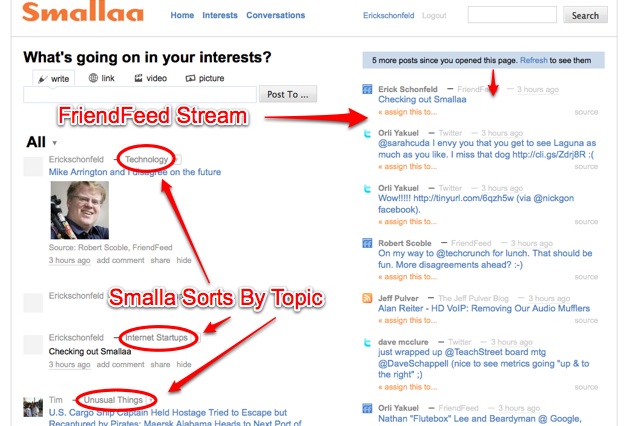
 Later, the article was much edited after
Later, the article was much edited after 

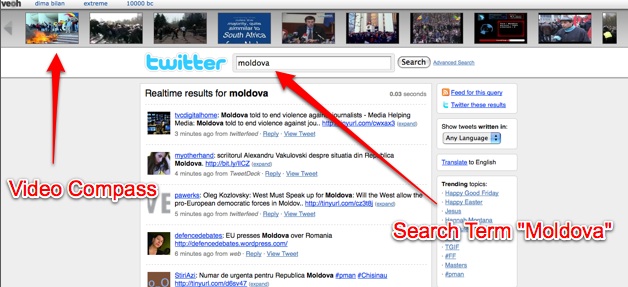
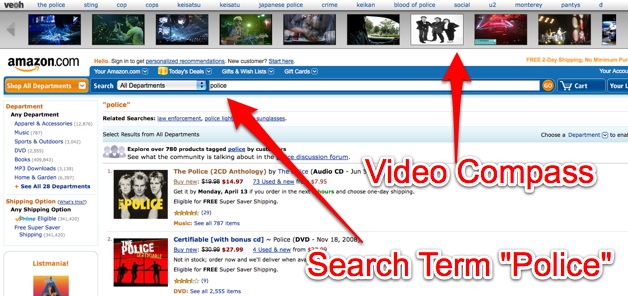
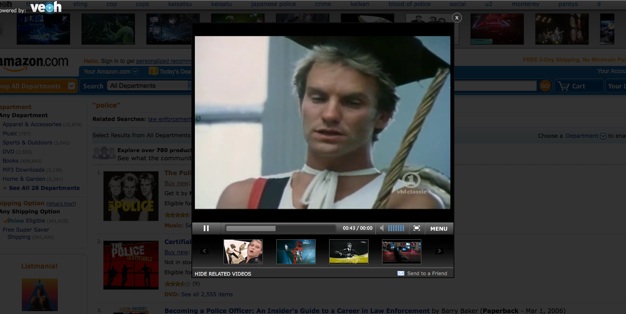
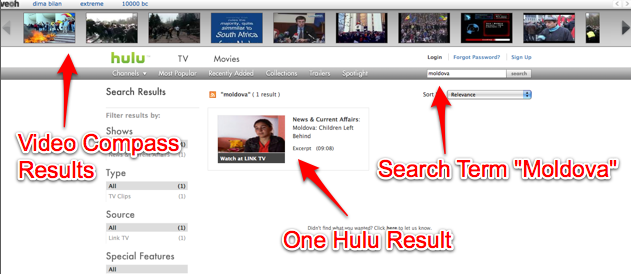

No comments:
Post a Comment